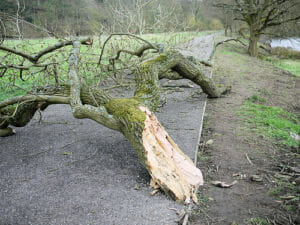Picture this: You’re walking through the forest on a hot, still day. Suddenly, you hear a popping sound, and then a huge branch drops just beyond your reach. After thanking your lucky stars that you weren’t crushed, you wonder why a limb should fall on such a windless, calm day? Googling your query, you might discover Sudden Branch Drop, a rather mysterious arboreal tendency that describes your experience.
As Portland tree care enthusiasts, we have many cases of mysteriously fallen limbs on perfectly calm days. Sudden branch drop, also known as sudden limb failure, happens on hot, calm days and evenings, typically in the summer. Observers will notice cracking or popping sounds just before large limbs suddenly plummet to the ground. Kellogg first described sudden branch drop in 1882, writing of trees “said to burst with a loud explosion, and strong limbs…(which) unexpectedly crash down, the fracture disclosing not the least cause of weakness.”
Why Sudden Branch Drop Occurs
Portland certified arborists could debate this question at length, as there is no industry-wide consensus. Most arborists suspect that it has something to do with humidity levels within the tree. Trees absorb water from the soil, and then distribute that water through all tissue—branches, trunk, leaves, limbs, and roots. The used moisture must be released somehow, and as it releases it cools the tree.
Humans release moisture and heat through sweat. Dogs “sweat” out of their tongues. Trees release water into the atmosphere through evapotranspiration, releasing moisture through their leaves. However, calm, hot conditions limit how much moisture trees can release. One theory on sudden branch drop holds that high humidity in tree canopies limits evapotranspiration, increasing the moisture content within branches, and eventually leading to limb failure.
Arborists and scientists continue to study why sudden branch drop happens. It is suspected that sudden branch drop could also be related to:
 a change in branch movement,
a change in branch movement,
• drought stress and very dry soil,- tissue shrinkage (due to heat),
- internal cracks,
• moisture changes in the air and soil,
• gas release inside tissue, potentially caused by wetwood bacteria, which are common in the species affected by sudden branch drop, and
• deterioration in cell wall structure, potentially caused by ethylene gas.
Basically, sudden branch drop is the tree’s response to hot, dry environment where transpiration needs exceed vascular capabilities. When it gets too hot to keep all tissue properly circulated, the tree responds with auto-amputation, letting go of a limb.
Tools to Prevent Against Sudden Branch Drop
Sudden branch drop has been known to happen along lines of weakness; however, it is also possible in branches with no apparent flaws. Therefore, it is hard to predict. In general, it’s a good idea to keep an eye on your trees, especially large, mature trees. Older oaks, maples, ashes, beeches, and elms are common victims of sudden branch drop, but it has occurred in dozens of other species as well. Trees with large, horizontal limbs with an upward sweep at the tips are more likely to suddenly drop limbs. Oftentimes, branches that suddenly drop are those that extended beyond the tree’s main canopy.
While inspecting your trees, look for discoloration, particularly a darker spot where water appears to be “bleeding” out of the tree. This is a sign of a potential limb flaw, which could contribute to limb failure.
Do not place benches or tables below older trees that may suffer sudden limb drop.
As always, consistent, expert Portland tree pruning is the best preventative action you can take to protect your trees from sudden branch drop. Schedule regular tree maintenance with our Portland certified arborists. Our ISA-certified arborists are pruning masters with expertise on how to best cut to minimize the chances of sudden branch drop. Portland tree trimming from less experienced, less knowledgeable pruners may leave excess foliage at the end of limbs, thereby increasing the burden the tree must support on hot, dry days. Sudden branch drop is dangerous for bystanders and detrimental to tree health. Protect against it with regular, professional pruning.
Check out what Brian had to say about us on Google.
“Great service from UFP. I’ve hired them on multiple jobs, and I find them very professional, quick, and careful. I won’t hesitate to call them again when I need an arborist.”
5/5 ⭐⭐⭐⭐⭐
(December 23, 2019)
This post first appeared on https://www.urbanforestprofessionals.com